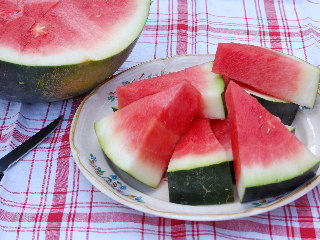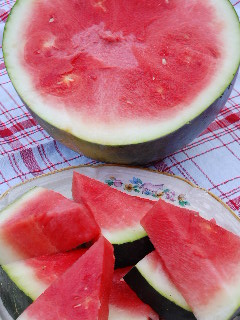
What’s green on the outside, red on the inside, and delicious all the way through? One of the most popular members of the gourd family—the watermelon.
Other well-known foods from this same family include cantaloupes, cucumbers, pumpkins, and squashes. All provide a high level of nutrition as well as fiber when incorporated into the diet, and all are relatively easy to grow in the home garden if their cultural needs are met.
Let’s take a look at growing your own watermelons and at the benefits of adding this simple but wonderful food to your dinner table or to your list of easy to prepare, healthy and delicious snack foods.
Watermelon vines need lots of sunshine and a long hot growing season to produce full-term, fully-ripe and plump melons. For this reason, you may want to start your seeds indoors while the weather is still cool and then transplant your tender young plants to the outdoor garden after all danger of frost has past.
Be sure to give your plants lots of room to grow, as the vines need at least 6 to 8 feet of space to run once they are established into your garden. A good way to set your watermelon seedlings (or seeds) into the soil is by building hills or mounds of dirt that are about 10 to 12 inches high and 12 to 14 inches in diameter. The hills themselves should be about 12 feet apart, which allows the vines plenty of room to spread.
In addition to providing room to roam for your wandering watermelon vines, another benefit of these mounds is that they provide a loose, rich, loamy bed that encourages the plants to establish a deep rooting system. As you build these mounds, be sure to add plenty of compost or other rich organic matter to the soil. Plant about 5 or 6 seeds or seedlings in each hill.

After planting, a mulch of wheat straw will help keep the soil from drying out. Add plenty of water during periods of little rainfall as the vines need lots of moisture to produce plump juicy melons.
Since the watermelons do not change their exterior color upon ripening, how can you tell when your watermelons are ready to pick? Some good indications are that the stem becomes tougher, drier, and somewhat brownish. Also, the curly little tendrils on the vine near the ripe melon will be drier and darker. The rind on the bottom side of the ripe watermelon is often more yellowish than white and this same bottom skin is sometimes more leathery than smooth in appearance.
If purchasing your melon at the market, these same stem and bottom texture and coloration features may also be helpful in trying to select a ripe watermelon.
Watermelons, and melons in general, are a good source of vitamins A and C and of potassium. They are low in calories on a per-serving basis, and as we have said earlier, they are a tasty and easy-to-serve side dish or snack. A slice of cold watermelon on a hot summer day is a fun and nutritious treat for kids and adults—a welcome addition to a picnic in the park. Enjoy some soon!
 What’s green on the outside, red on the inside, and delicious all the way through? One of the most popular members of the gourd family—the watermelon.
What’s green on the outside, red on the inside, and delicious all the way through? One of the most popular members of the gourd family—the watermelon.
 After planting, a mulch of wheat straw will help keep the soil from drying out. Add plenty of water during periods of little rainfall as the vines need lots of moisture to produce plump juicy melons.
After planting, a mulch of wheat straw will help keep the soil from drying out. Add plenty of water during periods of little rainfall as the vines need lots of moisture to produce plump juicy melons.